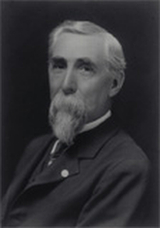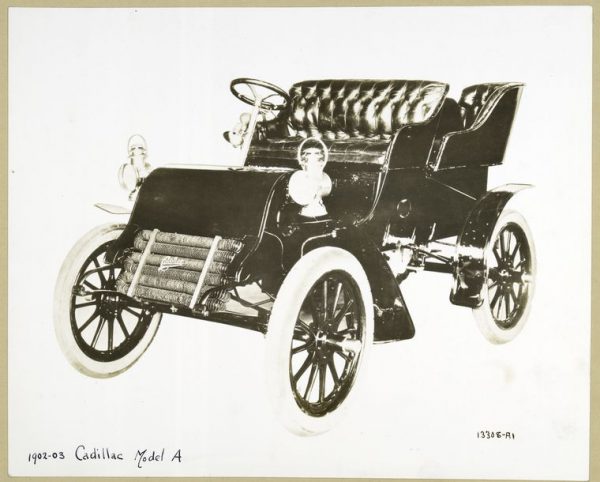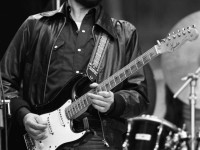
Henry Martyn Leland (1843-1932)
On February 16, 1843, American machinist, inventor, engineer and automotive entrepreneur Henry Martyn Leland was born. Leland founded Cadillac Motors (22 Aug 1902) to build the Cadillac, the first automobile with high-precision, fully-interchangable parts. During WW I, he formed a new company to manufactured aircraft engines, which after the war he produced a new automobile: the Lincoln.
“Mr. Sloan, Cadillacs are made to run, not just to sell.”, Henry Martin Leland, cited in [5]
The 19th Century Zeitgeist of Interchangeability
Henry M. Leland was born as the youngest of 8 siblings in Barton, Vermont, USA, to the hard working farm family of Leander and Zilpha Leland. By the time he reached the age of 14, Henry M. Leland had left the farm to seek his fortune. He learned engineering and precision machining in the Brown & Sharpe plant at Providence, Rhode Island. At that time, the industry being most exposed to modern machining techniques was gunsmithing. As the U.S. Civil War approached, most firearms were still pieced together using the artisan method. Frequently, due to their lack of parts commonality, no two guns were exactly alike, which made repairs or parts replacement in the field almost impossible. Nevertheless the Army, which demanded that rifles and other weapons be built en masse with interchangeable parts. Leland tried to enlist in the Union Army but was rejected for being too young. When the war ended, Leland found himself laid off at Massachusetts’s Springfield Armory, including at Colt, by then a dominant supplier of military weapons.[2] These experiences in toolmaking, metrology, and manufacturing steeped him in the 19th-century zeitgeist of interchangeability.
Leland’s Obsession with Precision
He applied this expertise to the nascent motor industry as early as 1870 as a principal of Leland & Faulconer, a successful gear grinding and tool manufacturing firm in Detroit. Leland was obsessed with precision, and as a company manager in 1876, shepherded the invention of the Brown and Sharpe Universal Grinder. It’s still considered one of the great advances in the machine-tool business.[2] That brought Leland directly into contact with bicycle producers that would later end up building automobiles. He also invented the electric barber clippers, and for a short time produced a unique toy train, the Leland-Detroit Monorail.

Cadillac Model A, 1903, : The New York Public Library. Science, Industry and Business Library. General Collection Division
Detroit and the Creation of Cadillac
In 1902, Leland was asked to help with the liquidation of the Detroit Motor Company, one of Henry Ford‘s earliest enterprises.[8] Instead, he suggested that the firm be reorganized to produce luxury automobiles. Ford, who was already envisioning the Model T, took his leave, and the company was building a new car powered by a single-cylinder engine Leland had originally developed for Oldsmobile. Leland suggested naming the car after the founder of Detroit, Antoine de la Mothe Cadillac.[2] The directors lost no time in renaming the company Cadillac. At Cadillac, Leland applied many modern manufacturing principles to the fledgling automotive industry, including the use of interchangeable parts. Alfred P. Sloan, longtime president and chair of General Motors, considered Leland to be “one of those mainly responsible for bringing the technique of interchangeable parts into automobile manufacturing.
Improving Automobile Technology
By 1908, Cadillac had five luxury models in its portfolio, all with fully interchangeable parts. That was revolutionary. Making a deal with the Royal Automobile Club, Leland sent three Cadillacs to London for a demonstration during which they were completely disassembled, the parts mixed up, and the cars put back together. For this accomplishment, the RAC awarded Cadillac the Dewar Trophy for design excellence.[2] Leland sold Cadillac to General Motors on July 29, 1909 for $4.5 million, but remained as an executive until 1917. With Charles Kettering, he developed a self-starter for the Cadillac, which won its second Dewar Trophy in 1913 as a result. He prodded Kettering to design a workable electric starter after a Cadillac engineer was hit in the head and killed by a starting crank when the engine backfired.
General Motors, Cadillac, and Lincoln
He left General Motors in a dispute with company founder William C. Durant over producing materiel during World War I. Cadillac had been asked to build Liberty aircraft engines but Durant was a pacifist. Leland founded Lincoln, later purchased by the Ford Motor Company. Leland formed the Lincoln Motor Company, got a $10,000,000 contract and started building the V12 Liberty engine. After the war, the company was reorganized, and the Lincoln Motor Company Plant was retooled to manufacture luxury automobiles. The V8 engine used in the first Lincoln automobiles is said to be influenced by the Liberty engine’s design. The 1921 Lincoln Model L, which went on sale late in 1920, was a well-engineered product with a level of workmanship befitting the Lelands’ reputation. Unfortunately, it had also had dated prewar styling, a problem that a subsequent restyling by Buffalo coachbuilder Brunn & Company did not completely alleviate. Even if the car had been stunning, the postwar economy was moribund and the market for luxury cars was soft. Lincoln had hoped to sell 6,000 cars in 1920, but the final tally was only about 700 and buyers canceled many early orders as the economy worsened.[3]
The End of Lincoln
In 1922, Lincoln became insolvent and was bought out by Henry Ford’s Ford Motor Company. After the sale, Leland and his son Wilfred continued to run the company, believing they would still have full control to run the company as they saw fit. Ford assigned a number of their people to Lincoln, they said to learn. However, it soon became clear they were there to streamline their production and stop the loss of money that had bankrupted Lincoln.
Henry Leland died on March 26, 1932, at the age of 89.
Rod Smith, Second Thursday Talk, December 2020, Henry Leland, [8]
References and further Reading:
- [1] Leland, Henry M., at Generations of GM History
- [2] Jim Donnelly, Henry M. Leland – The founding genius of both Cadillac and Lincoln, at Hemmings, The World’s Largest Collector Car Marketplace
- [3] Aaron Severson, The 19th Century Man: The Rise and Fall of Henry Martyn Leland, at Ate Up with Motors
- [4] H.M. Leland Dead; Motor Car Pioneer. New York Times. 27 March 1932.
- [5] David Farber. Sloan Rules: Alfred P. Sloan and the Triumph of General Motors, p. 14.
- [6] Henry M. Leland at Wikidata
- [7] Image grid of Cadillac cars, via Wikidata
- [8] Second Thursday Talk, December 2020, Henry Leland, National Automobile Museum @ youtube
- [9] Henry Ford and the Ford Motor Company, SciHi Blog





